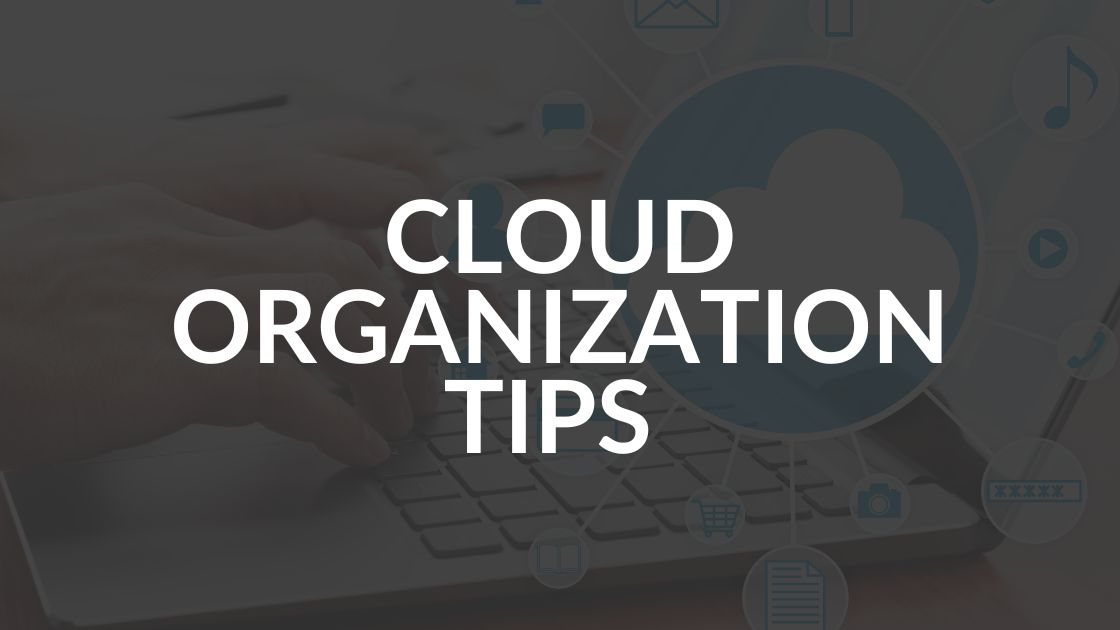8 Best Cloud Organization Tips (And Why You Should Use Them)

The cloud makes it easy to share, store and manage files, but without routine maintenance, it can become messier than a department store on Black Friday. As a managed service provider, this isn’t our first rodeo. The good news is there are several best practices for cloud organization that you can use to streamline your storage for increased productivity and efficiency. Here are eight of the best cloud organization tips.
1. Consider Systematic Organization
Before you set off on your cloud organization journey, set aside some time to think about how you’d like to store your files. Would you rather sort by category or maybe alphabetical order? Commit to a systematic method of storing files and inform your coworkers to eliminate any future confusion.
2. Create a Folder Naming Structure That’s Universal
One way to better organize your cloud is to separate your files into neat categories via a universal folder naming structure. As an example, if you make a folder named “Billing” all your billing and billing-related documents should go into that folder.
To optimize this category even more, make sub-folders like “Payroll” and “Taxes” to know exactly where everything important resides.
3. Limit Your Team to Three Sub-Folders
As you’ve likely gathered from the heading, a good practice is to keep your folder structure to three sub-folders or fewer. Anything more than that can create a bottomless pit where it feels like you’re double-clicking endlessly to find just what you’re looking for.
Bonus Tip: Make sure that you label your folders clearly. Use descriptive keywords like “benefits,” “taxes,” “insurance,” etc.
4. Group Items via Tags
If you’re looking for an easy way to group similar items together, use tags in your organizational efforts. Tag any file you upload to your cloud storage service, whether it’s a document, picture, video or anything else. Tags help you locate what you need faster, especially if you have a lot of files stored in your company’s cloud.
5. Merge Folders With Fewer Than 10 Files
When you make folders for just a few files, you’ll end up with too many unnecessary folders. This issue not only makes finding files more difficult but also intensifies your cloud’s disorganization. You can streamline your storage by merging folders with fewer than 10 files.
6. Clean Up Your System Regularly
As your
Here are three ways to clean up your system:
- Consolidating folders with fewer than 10 files to another folder
- Deleting unneeded documents
- Moving documents back to their proper folder
7. Move Older Files to an Archive
All companies have older files. As companies grow and expand, training documents, processes and other corporate documents become dated and unused. Consider moving unused files and folders to a master “Archives” folder to get the files out of the way of users.
As an added benefit, an archive folder still keeps the older files accessible if needed later.
8. Cultivate Best Practices Amongst Team Members
Everyone works differently, and, therefore, organizes things in unique ways, which is one reason why cloud storage can become messy. Cultivate cloud organization best practices by training your employees on how to save files correctly.
While it might feel like another thing added to their endless list of other work priorities, emphasize the associated benefits like enhanced workflows and time-saving potential.
Why You Should Use These Tips
Now that you know eight of the best cloud storage organization tips, it’s important to remember (and communicate to your team) why following them is worth all the effort. Your
Here are some of the best reasons to keep your cloud organized:
Backups
You never know when disaster will strike; that’s why it’s essential to have an organized cloud to ensure you have backup copies of videos, documents, pictures and anything else you might need to access later.
Accessibility
A disorganized cloud not only makes it hard to locate files but also creates a frustrating user experience. By enhancing file accessibility, you increase job satisfaction for your coworkers.
Efficiency
A well-organized cloud significantly reduces search queries and becomes less time-consuming. Increase your company’s efficiency by eliminating unnecessary files and creating an organization system to keep clutter at bay.
Productivity
It’s hard to focus on what matters most when you have a lot of files scattered around. By organizing your files, you’ll find yourself spending less time searching for the things you need to work and more time getting stuff done.
Increased Security
Prevent sensitive information from floating around on your cloud. Increasing your cloud organization helps increase your company’s overall cyber security by helping to prevent unauthorized access to important files.
Tracking
As a business professional, you need to know where everything is at any given time, or at least be able to locate whatever you need quickly. With a clean cloud, you’ll be able to keep track of all your files instead of guessing where your KPI document went or wondering about the details of your office’s latest birthday celebrations.
Sharing
If you’re collaborating on something together, there are times where you’ll need to work on documents across team members. Sharing files between coworkers is easier when everyone can access what they need quickly and easily.
Increased Space
As you and your business continue to add more files, you may notice your cloud storage starting to fill up. Having a system for storing files helps you create space for new projects.
Optimize Your Cloud Organization Strategy
The cloud makes your data accessible from anywhere at any time, making it an invaluable productivity tool. But with files being added every day, it can become messy and overwhelming almost overnight.
Use these cloud organization tips and partner with an experienced IT service provider to develop a system that promotes efficiency and minimizes clutter.
Contact us or schedule a quick meeting to explore cloud organization solutions designed to optimize your
Share this Blog

Is Your Name or Birthday a Part of Your Password?
If so, you’re a part of the 59 percent of people who don’t follow proper password hygiene. More than 70 percent of passwords are used for more than one system, meaning if cybercriminals crack one, they can access a lot more accounts.
Our free Enterprise Password Management Guide will give you the best password hygiene practices to help you secure your computer and your business.
Download the Guide
Explore the Latest Trends in IT

Microsoft 365 and Google Workspace: The Importance of Backing Up Your Cloud-Based Applications

AI Guiding Principles

Edge vs Chrome Security: Which Is the Best Browser for Your Business?




